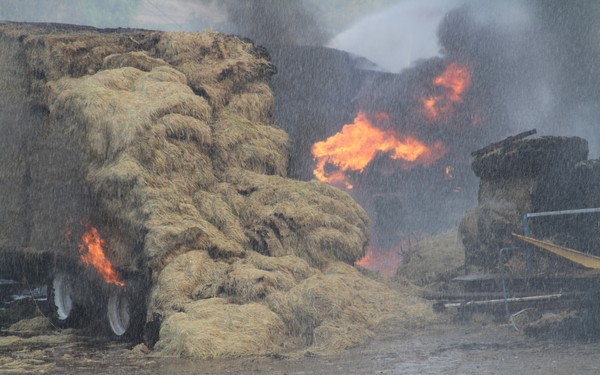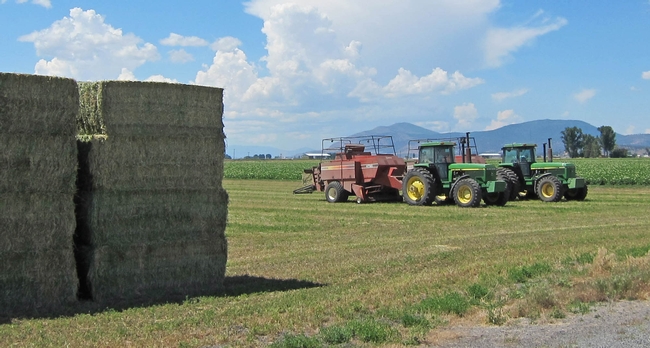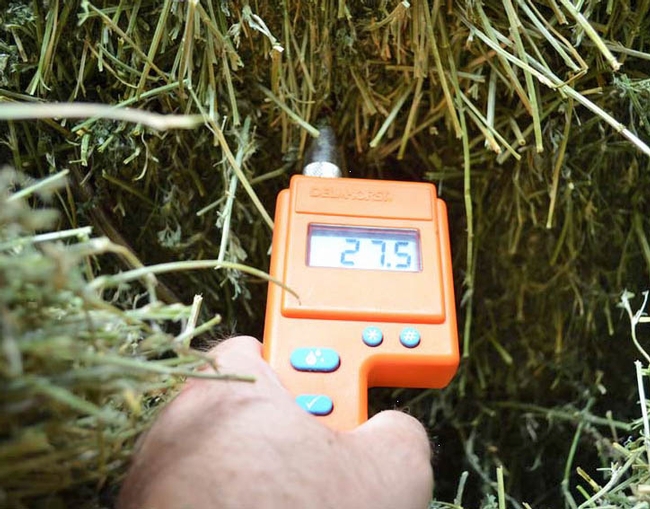“Hay fire continues to burn at Herald Ranch” (August 2012)
“Hay Truck catches fire on I-5" (Redding, November 2012)
“Firefighters Respond to Hay Fire Next to Santa Ana River" (November 2012)
One of the greatest fears of the hay grower is the possibility of rain or mold damage, which can easily drop the price of hay $50 per ton or more. However, this fear pales in comparison to the fear of a hay fire. Some hay fires result in million dollar losses or more.
Hay fires are all too common when stem and bale moisture is too high, and the bales haven't been adequately 'sweated' (when moisture and heat dispels from newly-baled hay) before movement and storage.
Fortunately, most growers have never had the misfortune of having a hay fire. However, we can all learn from the experiences of those that have had hay fires and the research that has been conducted on the topic. It turns out that the water content of hay, especially stem moisture, is a crucial part of the causes of hay fires (unless of course accidental combustion or arson is involved).
Putting up high quality alfalfa hay is a continual challenge for alfalfa producers. Not only is it one of the most time-consuming operations in the alfalfa production system, it is one of the most difficult. Many believe haymaking to be as much of an art as it is a science, and there are all kinds of different philosophies on the best technique—the role of stem moisture, dew moisture, incoming vs. outgoing dew, etc., etc.
So what causes hay to heat and potentially catch on fire? The process is called “spontaneous combustion”. This is somewhat of a misnomer—the process is far from spontaneous, but has a definite cause. Generally hay fires occur within 6 weeks after baling, but have been known to occur even after a year. It is a biologically-driven process which depends on the initial moisture content of the hay, the ease with which moisture can dissipate from the bales and environmental conditions.
Hay that is stored with high moisture continues to respire. In the process of respiration, plant sugars are converted to water and carbon dioxide. Plant respiration coupled with bacteria and mold activity produces heat. The increase in moisture from respiration and the heat from respiration and microbial growth can start a chain reaction that eventually causes temperatures to spiral and potentially result in spontaneous combustion. When temperatures exceed 170 to 190°F the situation is considered critical and it may be time to think about calling the fire department.
Stem Moisture is Crucial. The moisture content of the hay at the time of baling is the primary factor affecting the likelihood of a hay fire. One of the only good things about the drought this spring is that it has made for favorable curing conditions. However, even with favorable curing conditions hay fires can still occur. The maximum moisture content for safe storage of baled alfalfa hay depends on the size and density of the bale. The larger the bale and the higher the density, the greater is the risk of a hay fire.
Big Bales are Higher Risk. As more growers have switched to big bales, the frequency of hay fires has also increased. So understanding the maximum recommended moisture content for safe baling is critical. The maximum moisture content is generally considered to be 18-20% for small two-tie bales, 16-18% for three-tie bales and 14-15% for large bales. However, these numbers should not be considered absolute, and depending upon conditions (compaction, aeration, stacking), heating can occur at even lower moisture. Rain on recently baled hay that has not completed what is referred to as “the sweat” is also especially prone to spontaneous combustion because the introduced external moisture can initiate the chain reaction discussed above.
What about ‘Slugs’? These maximum bale moisture recommendations are generalizations. Having average moisture content below these values does not ensure you won’t have problems. The average moisture content of a hay lot may be well within the acceptable range, but there could be bales or portions of bales (slugs) at much higher moisture levels that may be sufficient to cause a fire. If water generated by respiration from the plant and molds cannot escape, the wet spot can become larger and larger driving heat and moisture into the surrounding hay. Another factor to consider is the source of the moisture. Stem moisture (moisture trapped within the stem) dissipates much slower than dew moisture (free moisture); and therefore, hay with a high percentage of stem moisture is generally believed to be at greater risk of a hay fire than hay with little stem moisture and mostly dew moisture.
So what can a grower do to prevent hay fires? As growers well know, it is critical to monitor moisture before and while baling. Experienced growers can tell a lot by visual appearance and feeling the hay. However, I personally like the electronic moisture meters as a backup (see Figure 2), especially when the conditions become more “marginal”. Baler mounted moisture sensors are particularly useful for big bales.
Remember that moisture meters are a useful tool but do not indicate the absolute true moisture content. Their accuracy is generally believed to be plus or minus 5 percent. In addition, they are better suited to detect dew moisture than stem moisture. Monitor at least the first 3 bales produced and then periodically throughout the baling period, especially when conditions change. A total of twelve readings from different ends of the bale per large bale are desirable. Bales that have any readings much above 20% or averages over 14-16% should be marked and stacked separately-away from structures or equipment. Stacking hay with an air gap between bales allows the moisture to dissipate more readily and can help avoid problems. Be certain all the bales fall at or below the acceptable range stated above for different bale sizes before storing hay in a barn. Also, when stacking different lots of hay (especially of different moisture contents) it is advisable to leave an air gap between them.
Following these guidelines and baling well within the ranges considered “safe” should help prevent hay fires from occurring. Then you are left just worrying about rain damage, which unlike hay fires is something totally beyond our control.
Figure 1. Large bales have become more common in the West and so has the risk of hay fires.
Figure 2. Electronic moisture meters are a useful tool to assist growers in baling at the proper moisture content. A bale with a reading like the one shown in the figure would be considered high risk and should be stacked outside and separate from other hay.

